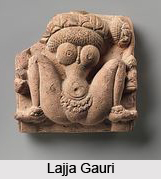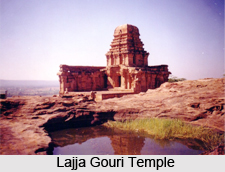 Lajja Gauri is a goddess who has been associated with fortune, abundance and fertility symbols. Lajja Gauri had been earlier depicted in Shaktism cults. According to historians she can be traced back to the Indus valley art of 2500-1500 B.C. She is worshipped and revered in the Deccan, a region of the Indian subcontinent. Lajja Gauri means an innocent goddess. `Lajja` denotes modesty. It is a manifestation of Parvati, the consort of Lord Shiva.
Lajja Gauri is a goddess who has been associated with fortune, abundance and fertility symbols. Lajja Gauri had been earlier depicted in Shaktism cults. According to historians she can be traced back to the Indus valley art of 2500-1500 B.C. She is worshipped and revered in the Deccan, a region of the Indian subcontinent. Lajja Gauri means an innocent goddess. `Lajja` denotes modesty. It is a manifestation of Parvati, the consort of Lord Shiva.
Iconography of Lajja Gauri
Laja Gauri has been represented through many ancient carvings. The best known images of the goddess have a female torso and a lotus flower in place of the head. Her legs are bent up at the knees and drawn up in a pose like one of `giving birth to a child` or `self-display`. The torso is extended to include breasts, and a fully blossomed lotus for head. It may have been inspired by purna kumbha. The iconography of the goddess descends from a group of early and well known symbols like lotus and purna kumbha or brimming pot. The images of Lajja Gauri are regarded as auspicious and beautiful. They are meant to protect against evil forces. These images are described as a `mother goddess`, a `nude squatting goddess`, or `a displayed female`.
The various forms of Laja Gauri are associated with the concept of fortune, fertility and reproduction. In Indian art, the lotus is the symbol of fortune, fertility and reproduction. It is also associated with ideas of purity and perfect wisdom.
In the year 1940 a marble image of Lajja Gauri with inscriptions carved on it was found atop Nagarjunakonda. In temples like the Lakulisa temple at Siddhanakolla and Bala Brahma temple at Alampur in Mahbubnagar district of Andhra Pradesh many Chalukyan images are still worshipped. A huge image of Lajja Gauri can be seen at the site of Mahakuta, near Badami in Karnataka. Many other Lajja Gauri idols are found in Osmanabad, Ahmednagar, Paunar, Ramatola in Maharashtra; Sannati, Siddheshwar temple in Gulbarga and Belgaum in Karnataka, Bhita and Allahabad in Uttar Pradesh, Sanchi, Bundelkhand and Rewa in Madhya Pradesh; Nagarjunakonda, Kudavelli, Sangameswara temple, Yellala, Bhavansi and Alampur in Andhra Pradesh; and Datasuram chakrayi temple in Thanjavur District of Tamil Nadu.
Lajja Gauri has also been associated with Lord Ganesha in the iconographic images. These are more commonly seen in Andhra plaques. Ganesha is a son of Shiva and Parvati. A snake is carved directly below the goddess. Terracotta figurines and statues of Lajja Gauri have been found in almost all the places in India, especially in Southern India. These usually date back to the 1st century AD. Majority of these idols were carved in the Gupta and post Gupta periods.
The names of Laja Gauri greatly vary from state to state and district to district. Few of the names by which the village folks refer Lajja Gauri are: Anantha Devi, Nagnamata, Kumkana, Aditi, Renuka, Elaba, Yellamma, Kotvi, Prithvi, Belam Kallachema, Nagna Kabandha, Verul, Kamalamukhi, Kamala Gaurima, Kamala Gangamma, Mahakundalini, Adyashakti, Jogulamba, Matangi, Maria, Mahuramma, Ekavira, Yamabai, Yamai, Vyaghreswari, Sang and Sakambari. These names describe her physical appearances 
Nagna Kabandha means `nude, headless body.` The word Nagna signifies nudity and Kabandha means torso. Sakambari means fertility goddess, associated with harvest. Yellamma (goddess of the boundary), Yellala, Yellesvara, Elapura, Alapuri, Alampur and Hamlapuri all bear the same meaning. Laja Gauri was originally worshipped as a Gramadevata. Her main function was to look after the well being of the family. However, since the fourth century onwards, she has been associated with Lord Shiva and has thus been elevated to the status of Parvati. All the ancient sites where images of Yellamma or Lajja Gauri were found were fertility worship centres.
Lajja Gauri entered the Hindu pantheon with a minor status. She had been worshipped for fertility as the mother goddess. Nevertheless, the images of Lajja Gauri were rarely made after the eighth century and not made at all after the twelfth century anywhere in India, but the worship of the goddess still continues in some temples.









